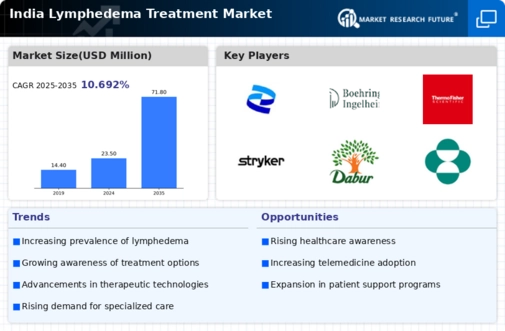Growing Geriatric Population
The increasing geriatric population in India is a significant driver of the lymphedema treatment market. As individuals age, the risk of developing lymphedema rises due to factors such as decreased mobility and the prevalence of chronic diseases. By 2030, it is projected that the elderly population in India will reach approximately 300 million, creating a substantial demand for healthcare services, including lymphedema treatment. This demographic shift necessitates a focus on specialized care and tailored treatment options for older adults. Consequently, healthcare providers are likely to expand their services to accommodate this growing population, thereby enhancing the lymphedema treatment market's scope and reach.
Rising Incidence of Lymphedema
The lymphedema treatment market is experiencing growth due to the increasing incidence of lymphedema in India. Factors such as cancer treatments, obesity, and genetic predispositions contribute to this rise. According to recent estimates, approximately 1 in 1,000 individuals may develop lymphedema, particularly post-surgery or radiation therapy for cancer. This growing patient population necessitates effective treatment options, thereby driving demand within the lymphedema treatment market. Furthermore, as awareness of the condition increases, more individuals seek medical intervention, further propelling market growth. The healthcare system's response to this rising incidence is crucial, as it influences the availability and accessibility of treatment options, including compression garments and physiotherapy.
Government Initiatives and Support
Government initiatives aimed at improving healthcare access and quality are significantly impacting the lymphedema treatment market. In India, various health programs focus on cancer care and chronic disease management, which indirectly address lymphedema. For instance, the National Health Mission has been instrumental in promoting awareness and providing resources for chronic conditions. Such initiatives may lead to increased funding for lymphedema treatment facilities and training for healthcare professionals. As a result, the market could see enhanced service delivery and patient outcomes. The government's commitment to improving healthcare infrastructure is likely to foster a more supportive environment for lymphedema treatment, ultimately benefiting patients and healthcare providers alike.
Advancements in Treatment Modalities
Innovations in treatment modalities are reshaping the lymphedema treatment market. The introduction of advanced compression therapies, such as pneumatic compression devices, has shown promising results in managing lymphedema symptoms. Additionally, the development of new surgical techniques, including lymphaticovenous anastomosis, offers potential solutions for patients with severe lymphedema. These advancements not only improve patient outcomes but also enhance the overall efficacy of treatment options available in the market. As healthcare providers adopt these innovative approaches, the lymphedema treatment market is likely to expand, catering to a broader range of patient needs. The integration of technology in treatment protocols may also lead to better monitoring and management of the condition.
Increased Focus on Patient-Centric Care
The lymphedema treatment market is witnessing a shift towards patient-centric care, emphasizing individualized treatment plans and holistic approaches. Healthcare providers are increasingly recognizing the importance of addressing not only the physical aspects of lymphedema but also the psychological and emotional well-being of patients. This trend is likely to lead to the development of comprehensive care models that integrate various treatment modalities, including physical therapy, counseling, and lifestyle modifications. As patients become more involved in their treatment decisions, the demand for personalized care solutions is expected to rise. This focus on patient-centricity may drive innovation within the lymphedema treatment market, ultimately improving patient satisfaction and outcomes.























Leave a Comment